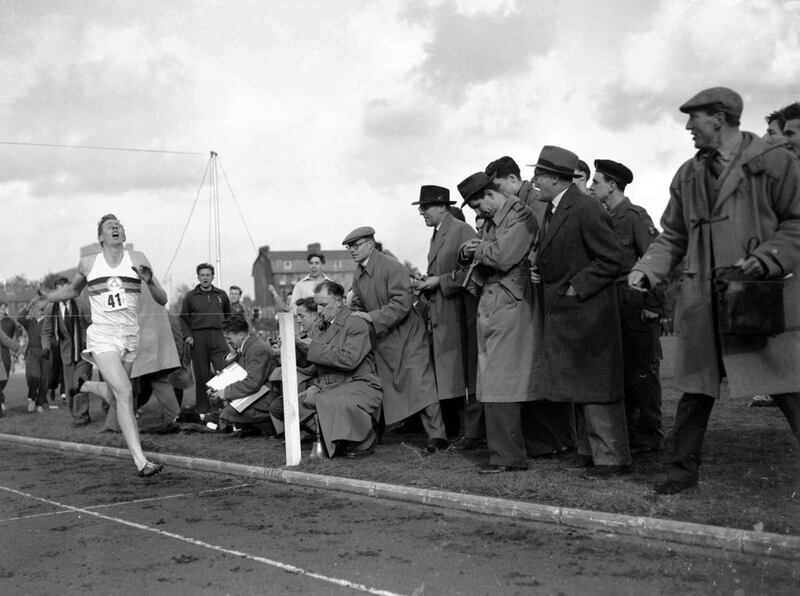Sixty years later, Roger Bannister is busy reliving the four minutes that still endure as a transcendent moment in sports history.
It was on a wet, blustery spring day – May 6, 1954 – that the lanky English medical student became the first runner to break the fabled four-minute barrier in the mile, a feat that many had thought was humanly impossible.
Helped by two pace makers, the 25-year-old Bannister completed four laps around a cinder track in Oxford in 3 minutes, 59.4 seconds, a milestone that captured the world’s fascination and resonates today.
“It was a target,” 85-year-old Bannister said in an interview at his Oxford home, a short distance from the Iffley Road track where he made his name.
“University athletes had been trying for years and it just didn’t seem to be capable of being broken. There was this magic about four symmetrical laps of one minute each. It was just something which caught the public’s imagination. I think it still remains something that is of interest and intrigue.”
Bannister’s record lasted 46 days, and he considers his victory over Australian rival John Landy a few months later as his greatest running exploit.
Yet, as today’s 60th anniversary attests, Bannister’s 3:59.4 remains part of track-and-field lore.
Bannister retired from running at the end of 1954 and went on to pursue a long career in neurology. The man knighted Sir Roger in 1975 is slowing down as the years pass.
He is coping with the effects of Parkinson’s disease, a neurological condition that falls under his medical speciality.
Bannister’s right ankle was shattered in a car accident in 1975 and he has been unable to run since. Now, he walks with crutches inside his home and uses a wheelchair outdoors.
Hundreds of athletes have run the mile in less than four minutes since Bannister did it and the world record has been broken 18 times. The current mark of 3:43.13 was set by Morocco’s Hicham El Guerrouj in 1999.
Bannister said he believes the two-hour mark in the marathon is the next barrier in the sport and will be broken in the next few years. The fastest time has been 2:03.23, run by Kenya’s Wilson Kipsang in Berlin in 2013.
“It involves a two per cent improvement,” Bannister said. “It has to be run on a day with the right temperature and on a course which isn’t too hilly, preferably a course which is a single line with the wind at your back all the way. It’ll be done.”
Bannister and his wife of 58 years, Moyra, will mark the anniversary at Oxford University with family and friends. Missing will be Bannister’s pace makers, Chris Brasher and Chris Chataway.
Brasher, who founded the London Marathon, died in 2003 at the age of 74. Chataway passed away in January at 82. “I miss them very much,” Bannister said. He went to the 1952 Helsinki Olympics as a favourite in the 1,500 metres, but struggled with the addition of an extra day of heats and finished fourth.
Retirement plans were put aside and Bannister decided to run for two more years to chase the four-minute mark. Swedish runner Gunder Hagg’s mile record of 4:01.4 had stood since 1945.
Landy and Wes Santee of the United States had both run 4:02 and were competing with Bannister to be the first under four minutes. “At one point, Landy said, ‘It’s like a brick wall. I’m not going to attempt it again’,” Bannister said.
“I, as a medical student, knew there wasn’t a brick wall. If you could run it in four minutes and 2.2 seconds, then you would find somebody else somewhere who trained a little better, had better conditions on the day, was able to use the pace judgment better, and they could do it. That was the frame of mind in which I approached it.”
Bannister chose to make his attempt during a meet between Oxford and the Amateur Athletic Association. After going through the first three laps in 3:01, Bannister knew he had to run the final lap in under 59 seconds.
He described the final, gruelling 300 yards in his book: “Those last few seconds seemed an eternity. ... I leapt at the tape like a man taking his last desperate spring to save himself from a chasm that threatens to engulf him.”
Landy lowered the record to 3:57.9 six weeks later in Finland. The two men then went head-to-head in August in the “Mile of the Century” or “Miracle Mile” at the Empire Games in Vancouver.
Bannister passed the Australian on the final bend and won in 3:58.8. Landy clocked 3:59, the first time two runners went under four minutes in one race.





